Lead Story
Roman Rooftops and American Catholic Studies
by Charles T. Strauss
The city of Rome invites travelers to reflect on the power of perspective. The ruins, gardens, churches, monuments, museums, piazzas, and pizzerias that cascade from the banks of the Tiber River are best explored on foot; and yet, the beauty of the whole can only be captured from a higher vantage point. It is no surprise, then, that Romans cherish the views from their terraces and rooftops. The University of Notre Dame only recently opened its Global Gateway in Rome, which serves as a home for academic programs and conferences. It is already drawing students and scholars to its beautifully renovated 32,000-square-foot facility on Via Ostilia with its stunning patio and terrace panorama of the Colosseum.
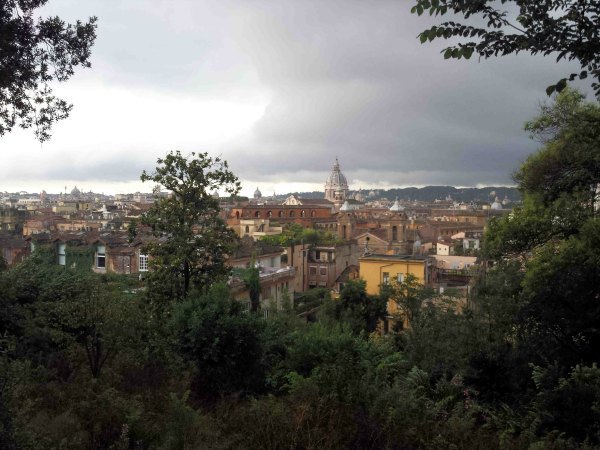
The view from Viale Gabriele D'Annunzio.
Photo by Michael Skaggs.
On the evening of June 6, 2014, a group of scholars from the United States, Europe, and South America, undeterred by jet lag, met on the Global Gateway terrace for a jovial sunset reception. The occasion for introductions and conversation was a lecture by Simon Ditchfield (University of York), “Thinking with Rome: Space, Place, and Emotion in the Making of the First World Religion.” Ditchfield invited the group to think of Rome as a “state of mind in addition to physical space.” He suggested that, historically, Ireland and New Spain could be understood as “microcosms of Rome.” The culture of Catholicism’s communion of saints, including holy relics, martyrologies, and icons, can serve as “portals to ancient Christian Rome,” Ditchfield said. Reimaginings of the “Madonna in the Snows” in Mexico, India, Japan, and China, for example, reveal the ways in which Catholics created “Little Romes” in the New World. “Thinking with Rome,” Ditchfield explained, “was a collective enterprise where the average soul could link with Rome while being thousands of miles away.” He offered the group a way to think about how Catholic institutions and missionaries, in particular, have created not just physical space but mental space as well. As the group discussed the ways in which Ditchfield’s lecture challenged them “to think with Rome” in their own scholarly work, their rooftop vantage of Rome prompted reflection on the ways in which the city had for centuries enchanted Catholics and non-Catholics alike.
The group that attended the Ditchfield lecture and sunset reception included participants in the 2014 Rome Seminar (#2014RomeSeminar), “American Catholicism in a World Made Small: Transnational Approaches to U.S. Catholic History.” From June 6 to 19, 2014, 23 scholars, ranging from graduate students to full professors, were joined by three convenors and 13 visiting presenters in an interdisciplinary seminar on an exciting new direction in the field of American Catholic Studies. Several entities at the University of Notre Dame sponsored the event, including the Cushwa Center, Italian Studies, the Nanovic Institute for European Studies, the College of Arts and Letters, and the Office of Research.
Kathleen Sprows Cummings and John T. McGreevy from the University of Notre Dame and Matteo Sanfilippo from the University of Viterbo convened and facilitated the seminar. In his opening remarks, McGreevy set the tone for the seminar when he described “the global history of Catholicism” as the “biggest historical opportunity of [his] lifetime.” Cummings recalled the life and legacy of the late Peter D’Agostino, whose groundbreaking work, Rome in America: Transnational Catholic Ideology from the Risorgimento to Fascism (2003), offered one of the first, sophisticated examples of the “international turn” in American Catholic studies. It was D’Agostino’s hope that more scholars would engage in this kind of work, and a scholarship named in his honor subsidized the costs for many in the seminar group.
Cummings, McGreevy, and Sanfilippo organized the two-week experience around nine formal sessions on theory, methods, and stories aimed at placing American Catholic history in an international perspective; they also offered in-depth tours of nine Catholic archives in Rome. The typical day included a morning seminar session and a tour of an archive in the afternoon, with opportunities to continue the conversation while sightseeing and enjoying Roman cuisine during lunchtime or in the evening.
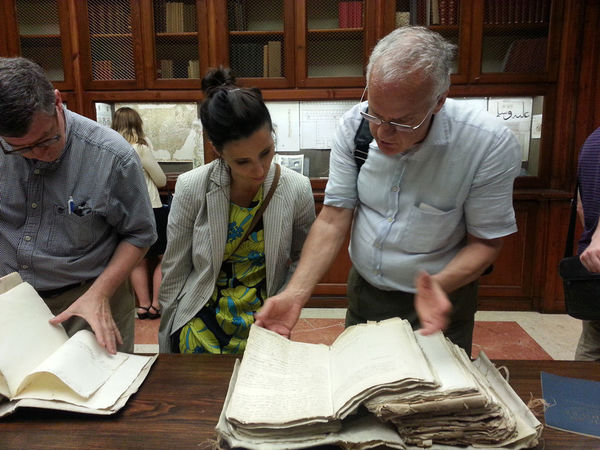 At the archives of the Congregation for the Doctrine of the Faith (Patrick Hayes, Gessica Cosi, Luca Codignola)
At the archives of the Congregation for the Doctrine of the Faith (Patrick Hayes, Gessica Cosi, Luca Codignola)
Theory, Methods, and Stories
The opening lecture, reception, and convenors’ remarks initiated the participants into the animating virtues of the seminar: seriousness, creativity, and collegiality. Over the next two weeks, the group focused on theory and periodization, Catholicism in the colonial and early republican periods, 19th- and 20th-century immigration, the Second Vatican Council, and late 20th-century globalization.
Several of the presentations explored the overarching narratives of American Catholic history and the ways in which transnational approaches enriched the wider historiography of the United States, and in some cases, overturned assumptions. Timothy Matovina (Notre Dame) facilitated the first seminar session by providing a survey of American religious history. After introducing a hemispheric approach to United States history, Matovina located the United States in world history. Matovina concluded by suggesting that scholars look for what the experience of Catholics in Mexico and in the United States had in common.
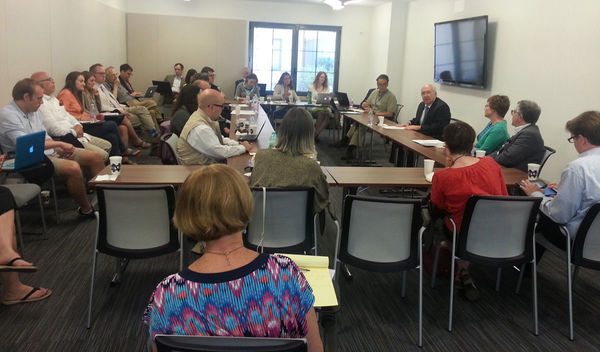 A morning class session at the Global Gateway
A morning class session at the Global Gateway
In another session, McGreevy emphasized the opportunities for historians to locate Catholicism within world history by focusing on the experience of 19th-century Jesuits: the Society of Jesus has sustained a global reach since its founding in the 16th century. McGreevy’s work drew attention to the ways in which Jesuits have influenced politics, economics, and religious and secular culture in North America, India, China, the Philippines, and elsewhere, for centuries. Florian Michel (Paris-Sorbonne University) explored the interconnections of transnational religious and intellectual history through a case study of Jacques and Raïssa Maritain in his presentation.
One session focused specifically on Catholicism during the late 18th-and early 19th-centuries: Luca Codignola (University of Genoa) explored “The Holy See’s Many Faces” from the colonial period to the Jacksonian era.
Sanfilippo introduced the experience of European immigrants in the 19th and 20th centuries into the discussion in his presentation on “The Vatican and the Migrant.” Maria Susanna Garroni (Roma Tre University) and Elisabetta Vezzosi (University of Trieste) explored Italian Catholic sisters and immigrants in New York City from 1880 to 1945.
Catherine O’Donnell (Arizona State University) and Cummings continued the discussion of immigration in their presentations on Elizabeth Ann Seton and the ethnic implications of “American Saints.” They each demonstrated how the transnational scale and Roman archives were crucial to their work. O’Donnell emphasized the transformation of a Protestant woman from a wealthy, urbane family into a Catholic founder of a religious community. Cummings provided a historical survey of American women and men who achieved sainthood and the contentions over their identities as Americans and as Catholics.
Massimo Faggioli (University of St. Thomas) and Leslie Woodcock Tentler (Catholic University of America) provided various opportunities to think of the Second Vatican Council and its aftermath in transnational perspective with Faggioli emphasizing archival sources and the conciliar debates and documents and Tentler focusing specifically on gender.
The seminar tackled contemporary history in three sessions. Daniel Fiorentino (Roma Tre University) narrated the history of the “peculiar relationship” between the United States, Italy, and the Vatican since 1870; he focused specifically on the presidency of Ronald Reagan. Fiorentino guided participants in a chronological survey of diplomatic relations between the United States and the Vatican, a state with a foreign policy and global influence but without temporal power beyond the walls of Vatican City. R. Scott Appleby (Notre Dame) and Charles T. Strauss (Mount St. Mary’s University) circled the themes of the Catholic missionary enterprise and specifically the role of U.S. Catholic missionaries in Central America, as well as their “reverse mission,” or their influence on the Catholic Church and U.S. government at home. Joseph P. Chinnici (Franciscan School of Theology) explored the implications for the historian of Catholicism as a global church within the geopolitics of the Cold War. Chinnici noted the increasing awareness by Catholic Church leadership in Rome and around the world of Catholicism’s global and transnational institutional character.
The seminar presenters each made provocative historical claims, pointed to the opportunities (and often the challenges) of the transnational approach, and defended their arguments and observations with careful case studies. The seminar participants responded with probing questions, counterexamples, and historical evidence from their own scholarship and research projects.
Sources
The discussions of theory, methods, and stories of transnational American Catholic history extended beyond the seminar room as participants navigated Roman streets and public transportation to visit archives (see sidebar). For example, a visit to Civiltà Cattolica, the Jesuit journal published in Rome since 1850, included an introduction to the periodical’s expansive archive. After a tour by one of the editors, Pierre de Chantenay, S.J., the group headed for the rooftop where de Chantenay regaled them with stories about the historical relationship between the papacy and the Society of Jesus.
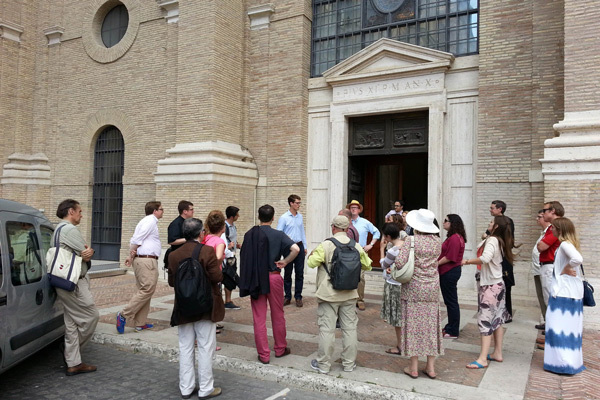 Outside the Vatican Secret Archives
Outside the Vatican Secret Archives
The group had a similar experience at the Vatican Secret Archives, where they received a guided tour of the massive complex, which culminated in a climb to the top of the Tower of the Winds and a breathtaking view from the terrace. The tour also included a tutorial on the procedures for accessing archival material and an explanation of which collections were open and closed. Seminar participants left each of these archival experiences with inspiration to craft even more rigorous and creative research agendas for themselves and a much better sense of how to organize the logistics to make them happen.
“Seeing the guts of the Vatican Secret Archive is, for an archivist, a little like being a surgeon about to perform her first operation,” explained Patrick Hayes, archivist for the Redemptorists of the Baltimore Province and a seminar participant. “You know where everything is supposed to be but you don’t really know the arrangement until you get inside.” Hayes conducted a tour of the Redemptorist Archives in Rome for fellow seminar participants. He persuaded the group that access to Roman archives was easier than they might have thought and encouraged members to think creatively about “how collections can help give shape or tone to one’s work.”
Collaboration and Community
If the sessions and archival visits exceeded participants’ expectations, the collegial spirit that animated the entire seminar was an unexpected and welcomed aspect of the experience. This was most evident in the vigorous discussion at the formal sessions, but it was clear at other times as well. The group committed to helping each other improve their Italian vocabulary, under the direction of seminar participants Marie Patricia Williams (University of London, Institute of Education) and Gessica Cosi (independent scholar). Each day Cosi, a native Italian speaker, introduced a new set of archive-related terms. The group also shared notes and reactions on Twitter (#2014RomeSeminar) and through a shared Google Drive folder, which they have continued to consult and update upon their return home. These now stand as helpful digital sources and opportunities for collaboration. Michael Skaggs (Notre Dame) appreciated “the opportunity to work with new colleagues on a daily basis beyond the rushed coffees and lunches of a weekend conference.”
“I found myself having wonderful discussions with scholars outside my own field and discipline,” continued Skaggs, “which is something that only the Rome Seminar could accomplish. The variety of training and current projects forced all of us to view our own work in very new ways and raised questions we hadn’t considered before.”
The community spirit also permeated several group meals, a guided tour of the Pontifical North American College, as well as a special lecture at the Pontifical University of the Holy Cross, the home university of conference participant Frederico M. Requena. Many participants took advantage of an early edition of a book of “Roman Walks,” written by Chiara Sbordoni for visitors to Notre Dame’s Global Gateway. Some in the group went to mass on Pentecost at the Pantheon: the liturgy concluded with Roman firefighters dropping rose petals from the structure’s oculus. On the final evening of the seminar, many participants attended mass for the feast of Corpus Christi celebrated by Pope Francis outside the Basilica of Saint John Lateran, which concluded with a procession to the Basilica of Santa Maria Maggiore.
During the closing session, participants recapped some of the highlights of the previous two weeks and brainstormed possibilities for the future. First and foremost, the new connections between participants, presenters, and others during the seminar underscored the significance of collaboration.
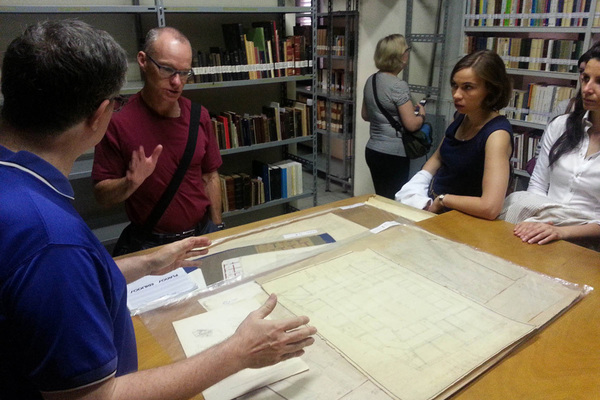 From Left: Patrick Hayes, Tony Smith, Gabrielle Rocaboy-Guillerm, and Gessica Cosi In the Redemptorist Archives
From Left: Patrick Hayes, Tony Smith, Gabrielle Rocaboy-Guillerm, and Gessica Cosi In the Redemptorist Archives
Participants were in agreement that internationalizing U.S. Catholic history was crucial for the advancement of the field, but that transnational approaches would require continued collaboration and support from institutions like the Cushwa Center. Language training, access to and orientation in Vatican archives, and travel support are all vital to this new direction in the field. To that end, one of the suggestions that the seminar conveners immediately implemented was work on an English-language guide to archival material in Rome (see page 7).
As the seminar reached its end, the group welcomed an unexpected guest. Ambassador Ken Hackett worked for Catholic Relief Services for 40 years, ultimately serving as its president. In 2013 the U.S. Senate confirmed Hackett as United States Ambassador to the Holy See. Hackett addressed the seminar and fielded questions; he specifically emphasized the papacy of Francis and encouraged the group that the work they had undertaken was important to the church and the world. Before departing, he joined the 2014 Rome Seminar for a rooftop photograph. The seminar concluded officially where it had begun: on the terrace. This time, upon doing the hard work of recalling, together, the major texts and turns in the historiography while also thinking seriously and creatively about opportunities to move American Catholic Studies forward, the group had an even richer sense of the beauty of the whole.
Rome Seminar Archive Visits
- The Archives of Propaganda Fide
- Archive of the Congregation of the Doctrine of the Faith
- Vatican Secret Archives
- Jesuit Archives (ARSI: Archivum Romanum Societatis Iesu)
- The Archives of Civiltà Cattolica
- General Archives of the Society of the Sacred Heart
- The Redemptorist Archives
- Archive of the Daughters of Mary Help of Christians (Salesian Sisters of Don Bosco)